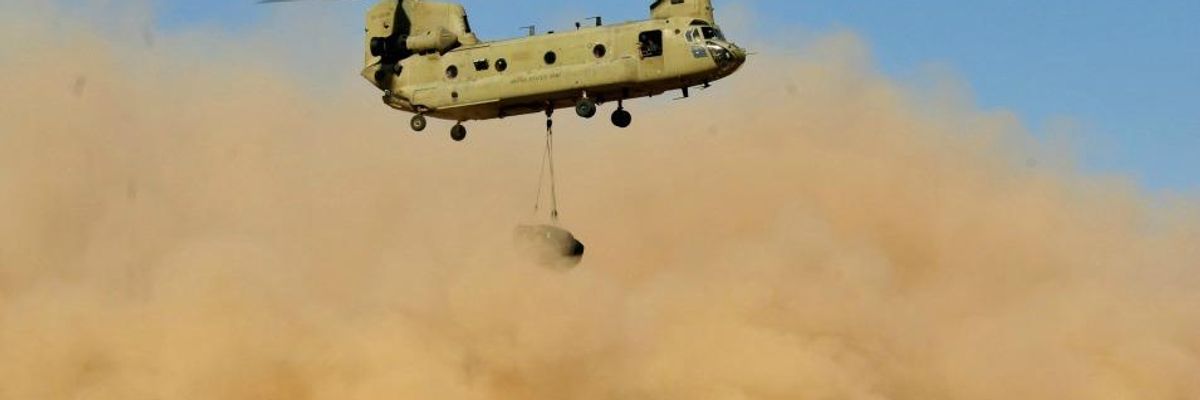
A U.S. Army helicopter taking off from Forward Operating Base Shindand, Afghanistan, Oct. 3, 2012. (Photo: DoD/public domain)
To donate by check, phone, or other method, see our More Ways to Give page.

A U.S. Army helicopter taking off from Forward Operating Base Shindand, Afghanistan, Oct. 3, 2012. (Photo: DoD/public domain)
Just months away from what President Obama refers to as the "end of the U.S. combat mission" in Afghanistan, the U.S. military escalated its air bombardments on the country.
In response to an information request from the Boston Globe, Central Command revealed that during the month of August, the U.S. carried out 436 "weapons releases" on Afghanistan, referring to air strikes. This is the highest number of air strikes on Afghanistan since August 2012, according to U.S. Central Command's own data, pictured in the graph below.

Military officials are still working to compile data for the month of September, officials told the paper.
The data was released just over a week after Afghanistan's new president, Ashraf Ghani, approved the U.S. Bilateral Security Agreement, which locks in at least another decade of U.S. military presence in the country, far past the formal "end" to the war at the conclusion of this year. The heightened bombings, furthermore, were revealed the same week the "longest war" entered its 14th year.
Donald Trump’s attacks on democracy, justice, and a free press are escalating — putting everything we stand for at risk. We believe a better world is possible, but we can’t get there without your support. Common Dreams stands apart. We answer only to you — our readers, activists, and changemakers — not to billionaires or corporations. Our independence allows us to cover the vital stories that others won’t, spotlighting movements for peace, equality, and human rights. Right now, our work faces unprecedented challenges. Misinformation is spreading, journalists are under attack, and financial pressures are mounting. As a reader-supported, nonprofit newsroom, your support is crucial to keep this journalism alive. Whatever you can give — $10, $25, or $100 — helps us stay strong and responsive when the world needs us most. Together, we’ll continue to build the independent, courageous journalism our movement relies on. Thank you for being part of this community. |
Just months away from what President Obama refers to as the "end of the U.S. combat mission" in Afghanistan, the U.S. military escalated its air bombardments on the country.
In response to an information request from the Boston Globe, Central Command revealed that during the month of August, the U.S. carried out 436 "weapons releases" on Afghanistan, referring to air strikes. This is the highest number of air strikes on Afghanistan since August 2012, according to U.S. Central Command's own data, pictured in the graph below.

Military officials are still working to compile data for the month of September, officials told the paper.
The data was released just over a week after Afghanistan's new president, Ashraf Ghani, approved the U.S. Bilateral Security Agreement, which locks in at least another decade of U.S. military presence in the country, far past the formal "end" to the war at the conclusion of this year. The heightened bombings, furthermore, were revealed the same week the "longest war" entered its 14th year.
Just months away from what President Obama refers to as the "end of the U.S. combat mission" in Afghanistan, the U.S. military escalated its air bombardments on the country.
In response to an information request from the Boston Globe, Central Command revealed that during the month of August, the U.S. carried out 436 "weapons releases" on Afghanistan, referring to air strikes. This is the highest number of air strikes on Afghanistan since August 2012, according to U.S. Central Command's own data, pictured in the graph below.

Military officials are still working to compile data for the month of September, officials told the paper.
The data was released just over a week after Afghanistan's new president, Ashraf Ghani, approved the U.S. Bilateral Security Agreement, which locks in at least another decade of U.S. military presence in the country, far past the formal "end" to the war at the conclusion of this year. The heightened bombings, furthermore, were revealed the same week the "longest war" entered its 14th year.